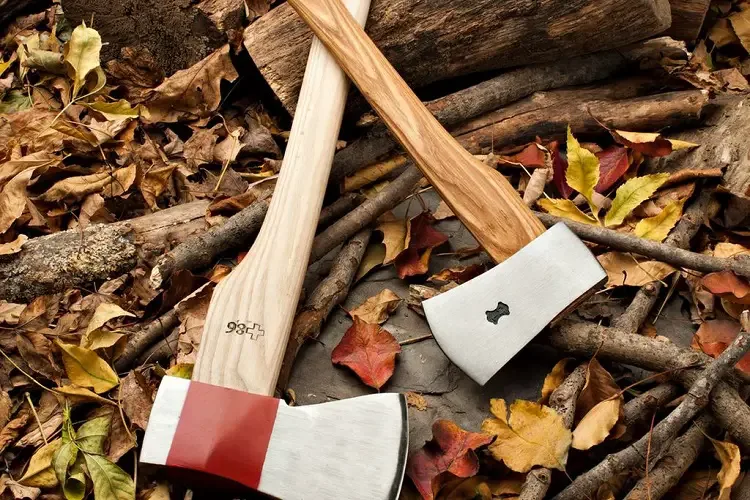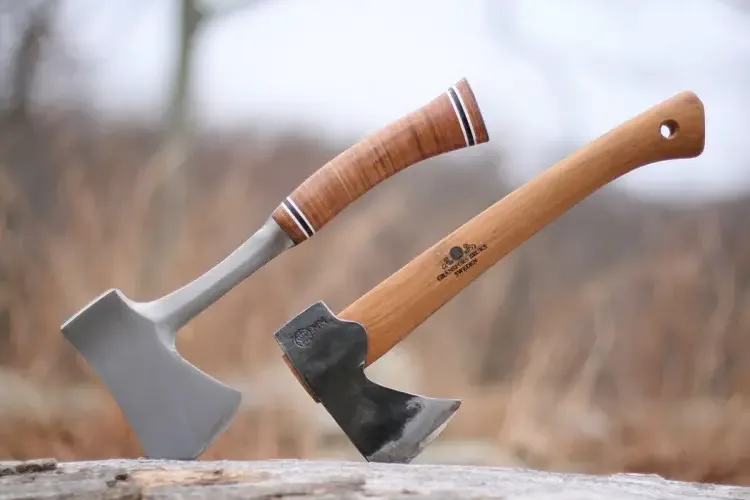SHTFDad may collect a share of sales or other compensation from the links on this page.
In the cutting tools world, two iconic tools stand out for their undeniable power. We are talking about hatchet vs axe.
People have been using these tools for centuries. And although their purpose is almost the same, they have distinctive features.
The hatchet is a smaller and more portable counterpart of the axe. Its small size and light weight make it suitable for one-handed operation.
It has outstanding mobility in small places. The hatchet, with its sharp blade and solid handle, is ideal for activities such as:
- Preparing a fire
- Limbing
- Minor woodworking
The axe, on the other hand, has a longer handle and a larger handle. Its heavier head makes it a force to be reckoned with.
The longer lever and substantial cutting edge allow the axe to create big blows. With it, you can effectively split large logs and trees.
Now let’s go deeper into the unique features.
Similarities: What They Have in Common
Although we compare hatchet vs. axe, they have several things in common. Here are some key aspects where these two cutting tools converge:
- Function – You can use these tools for chopping, splitting, and cutting. They’re great for tasks that require the application of force.
- Blade composition – A sharp metal blade is affixed to the handle. A blade made of steel or a similar robust material is available. It enables it to maintain its cutting edge even after extended use..
- Handle – They have a handle that provides grip and control over the tool. However, it is worth noting that hatchets and axe have a difference in handle length.
- Versatility – Both tools are distinguished by their versatility of use. Whether splitting firewood, shaping wooden pieces, building structures, or clearing paths in the wilderness, both axes demonstrate their adaptability to various tasks.
- Outdoor utility – Hatchets and axes are widely appreciated for their outdoor utility. They are indispensable tools for campers, hikers, hunters, and survival enthusiasts.
- Historical significance – Both axes and axes have an important place in human history. People used them for centuries for survival, construction, and warfare.
By comparing hatchet and axe, you will find out commonalities. These wonderful tools remain fundamental to a variety of activities. They demonstrate their continued relevance in the modern world.
Differences: What Categorically Distinguishes Them From Each Other
You already know that axes and axes have common features. Let’s not forget that they are different things, so hatchet, and axe have differences.
Let’s explore the key differences between these two formidable cutting tools:
- Size and weight – One of the main differences is their size and weight. Hatchets tend to be smaller and lighter and have a compact design. On the other hand, the axes are larger and heavier, with a longer handle and a more massive head.
- Cutting edge and blade design – Hatchet blades often have a narrower profile. It allows for more precise cuts and more control over the process. In contrast, axe blades are wider and heavier. It contributes to powerful strokes and efficient chopping.
- Length and handle design – Another significant difference is the length and design of the handle. Hatchets usually have shorter handles, 10 to 15 inches. Axes have longer handles, usually 20 to 36 inches.
- Application – Hatchet vs. axe have virtually identical uses. But you can use them for different tasks. Hatchets are usually used for lighter tasks such as trimming limbs and making fires. Axes are better suited for heavier tasks. These include felling trees, splitting logs, and construction projects.
- Portability – Due to their smaller size and lighter weight, hatchets offer enhanced portability. Axes, on the other hand, are less portable because of their larger size and weight. People often use them in stationary or controlled environments.
- Specialized varieties – Hatchet and axe sets also have specialized varieties. For example, people have developed hatchets specifically for throwing sports or tactical purposes. Similarly, people optimized some axes for specific chopping or cleaving requirements.
Hatchets and axes have a significant difference. These differences allow each tool to excel in specific applications. They provide users with a wide range of options.
When to Use Each Tool
Comparing a hatchet and an axe, you can see that they are designed for different things. Let’s look at the situations in which each tool performs at its best.
Hatchet Uses
- Camping and survival – Hatchet- indispensable companions in camping and survival. They are ideal for tasks such as limbing and collecting firewood. Their compact size and portability make them ideal for nature hikes.
- Shrubbing and woodworking – They are great for shaping parts, cutting notches, making fires, and so on. Working with one hand allows you to do more complicated detail work.
- Emergencies – In emergencies, an axe can be a lifesaver. It can help you in matters of survival, for example. It helps clear debris, create temporary shelters, and gather necessary resources.
- Throwing sports and competitions – The hatchet is gaining popularity in the throwing sport. These hatchets have a balanced weight distribution. Their comfortable handle will help you with accuracy and throwing efficiency.
Axe Uses
- Logging and feeling – Axes are the primary tool for felling trees and handling logs. They have longer handles and heavier heads. They, therefore, create more force and power when feeling. It makes them suitable for larger jobs.
- Chopping firewood – Unlike hatchets, axe sets are very effective at splitting firewood. Their wide blade allows you to quickly split logs into manageable chunks.
- Construction and Destruction – Axes find their place in construction and demolition. The force and impact allow you to get the job done efficiently. You can easily demolish small buildings and give materials a rough shape.
- Heavy-duty chopping – The Axes are the tool for heavy-duty work when it comes to construction, chopping large branches, or clearing land for construction or landscaping. Their large cutting edges allow the application of considerable force.
Choosing the right tool for the job ensures efficiency and safety. And that means you’re already geared up for successful chopping tasks.
How to Care for Hatchet and Axe Sets
So we have already compared hatchet and axe; now it’s time for the next step. You must ensure that your tools are properly cared for and maintained.
That way, they will provide optimum performance and longevity. Here are some important tips for you to keep in mind.
Hatchet Care
- Keep it clean – After each use, clean your hatchet by removing debris or sap from the blade and handle. Use a brush or cloth with mild soap and water, and ensure it is completely dry before storage.
- Sharpen the blade – Check the sharpness of the blade at regular intervals and sharpen it if necessary. Follow the manufacturer’s recommendations for the proper angle and sharpening technique.
- Lubricate the metal parts – Apply a thin layer of oil to the metal parts of the hatchet. It will help prevent rust and corrosion.
- Care for the handle – Inspect the handle for any cracks or damage. If necessary, sand away any irregularities and apply a protective coating. It will keep the handle in good condition.
Axe Care
- Clean and dry – Like a hatchet, clean axe sets after each use, removing dirt, wood chips, or moisture. Dry it completely to prevent rust formation.
- Sharpen the blade – Regularly sharpen the axe blade to maintain its cutting efficiency. Use a file or axe-specific sharpening tool to achieve a keen edge.
- Handle protection – Apply a protective coating to prevent moisture absorption and cracking. Regularly inspect the handle for any signs of wear or damage.
- Storage – Store the axe in a dry place, away from direct sunlight and extreme temperatures. Hanging or using covers will help prevent accidental damage.
Follow these care tips. That way, you can ensure durability and functionality. It will allow them to last for years to come.
Which Tool Is Best for Survival: Hatchet vs Axe
In survival situations, the hatchet often takes the lead. It acts as the preferred tool. It is because it is compact, portable, and versatile. You can work with one hand. Its narrow blade allows you to make precise cuts where you need them.
The axe is undoubtedly powerful for heavy cutting and logging jobs. However, it is larger in size and weight. If you compare a hatchet vs an axe, the axe is less practical in survival scenarios.
All because mobility and efficiency are important there. That’s crucial, so in this situation, the axe is no match for it. If you need to perform basic chopping tasks, for example, this option is the perfect choice for you.
It is vital to consider each survival scenario’s specific needs and circumstances. There are many factors to consider when choosing the best survival tool.
Be sure to sort out resource availability, anticipated tasks, and personal preferences. Ultimately, the hatchet’s compactness, versatility, and ease of use make it a valuable companion in the wilderness.
References:





